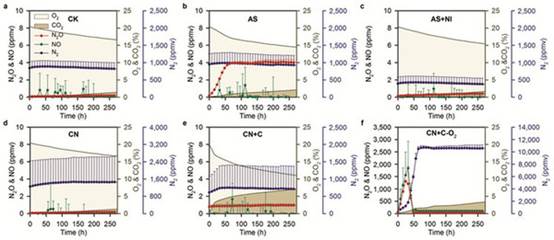石灰性低碳旱作土壤N2O产生机制阐明
来源:《科学报告》
作者:巨晓棠等
时间:2014-05-12

日前,在国家自然科学基金的持续资助下,中国农业大学资源与环境学院巨晓棠课题组经过持续研究发现,氨氧化是石灰性低碳旱作土壤氧化亚氮(N2O)产生的主要驱动因素,相关成果发布在《自然》旗下的《科学报告》上。
欧洲科学家的主流观点认为,N2O的产生主要是反硝化菌的反硝化作用,而这种结论大多是在欧洲高碳高湿土壤上获得的。自2000年以来,巨晓棠教授深入开展了集约化石灰性低碳旱作土壤N2O产生机制的研究,于2011年在Environmental Pollution上率先提出了石灰性旱作土壤N2O主要来自铵态氮肥(或尿素态氮肥)硝化作用的观点。经过十余年潜心试验研究,此篇《科学报告》文章证明在铵态氮肥(或尿素态氮肥)大量施入土壤后,氨的氧化作用消耗大量氧气,并积累硝化作用的中间产物亚硝态氮,在缺氧条件下诱发硝化细菌的反硝化作用,且这些过程能被硝化抑制剂有效地阻止。文章进一步提出了低碳旱作土壤可以通过避免一次性向土壤中施入高量铵态氮(或尿素态氮)减缓硝化作用速率,从而起到N2O减排的目的。
该成果是巨晓棠课题组在国家自然科学基金项目的持续资助下取得的主要创新性研究成果之一,对全球广泛分布的此类农业土壤的N2O减排具有重要的指导意义。这一研究工作先后得到国家自然科学基金重点项目“华北平原农田土壤硝化和反硝化的产物比及调控机制”,面上项目“添加碳对累积硝态氮的固持及减少损失的机制”“华北平原典型农田土壤N2O的产生机理” “华北平原典型农田土壤氮素总通量和氮饱和度的原位研究”的资助。(来源:中国科学报 萧杨)
Ammonia-oxidation as an engine to generate nitrous oxide in an intensively managed calcareous Fluvo-aquic soil
Abstract We combine field observations, microcosm, stoichiometry, and molecular and stable isotope techniques to quantify N2O generation processes in an intensively managed low carbon calcareous fluvo-aquic soil. All the evidence points to ammonia oxidation and linked nitrifier denitrification (ND) being the major processes generating N2O. When NH4+-based fertilizers are applied the soil will produce high N2O peaks which are inhibited almost completely by adding nitrification inhibitors. During ammonia oxidation with high NH4+ concentrations (>80 mg N kg−1) the soil matrix will actively consume oxygen and accumulate high concentrations of NO2−, leading to suboxic conditions inducing ND. Calculated N2O isotopomer data show that nitrification and ND accounted for 35–53% and 44–58% of total N2O emissions, respectively. We propose that slowing down nitrification and avoiding high ammonium concentrations in the soil matrix are important measures to reduce N2O emissions per unit of NH4+-based N input from this type of intensively managed soil globally.
原文链接: http://www.nature.com/srep/2014/140204/srep03950/pdf/srep03950.pdf




